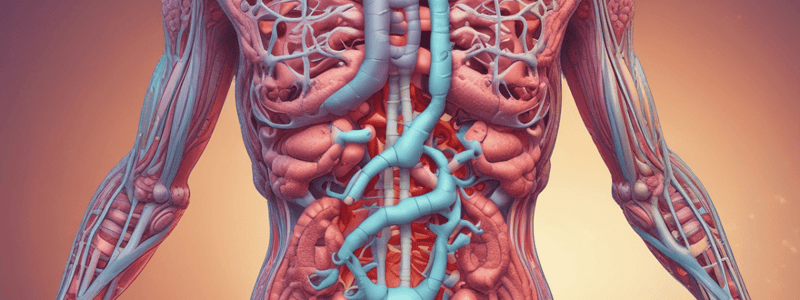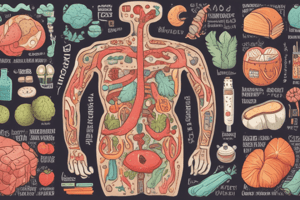Podcast
Questions and Answers
What is the primary mechanism of protein absorption in adults?
What is the primary mechanism of protein absorption in adults?
- Luminal proteases and brush border peptidases
- Direct uptake of amino acids through the apical membrane
- Absorption of dipeptides, tripeptides, or tetrapeptides through a H+-driven cotransporter (correct)
- Intact protein uptake through a cellular route
The absorption of amino acids across the small intestine requires only movement across the apical membrane.
The absorption of amino acids across the small intestine requires only movement across the apical membrane.
False (B)
What is the characteristic of lipids that distinguishes them from other substances?
What is the characteristic of lipids that distinguishes them from other substances?
Preferential solubility in organic solvents, compared with water
Amino acids exit enterocytes through _______________ transporters and enter through _______________ transporters.
Amino acids exit enterocytes through _______________ transporters and enter through _______________ transporters.
Match the following protein absorption mechanisms with their descriptions:
Match the following protein absorption mechanisms with their descriptions:
What is the process by which glucose is absorbed in the small intestine?
What is the process by which glucose is absorbed in the small intestine?
SGLT1 can transport fructose.
SGLT1 can transport fructose.
What is the protein responsible for the apical step of fructose absorption?
What is the protein responsible for the apical step of fructose absorption?
The basolateral membrane uses the facilitated sugar transporter, _______________, to exit all three monosaccharides.
The basolateral membrane uses the facilitated sugar transporter, _______________, to exit all three monosaccharides.
Match the protein digestion pathway with its description:
Match the protein digestion pathway with its description:
Amino acids can be absorbed directly without digestion.
Amino acids can be absorbed directly without digestion.
What is the purpose of luminal enzymes in protein digestion?
What is the purpose of luminal enzymes in protein digestion?
What is the result of protein digestion in the small intestine?
What is the result of protein digestion in the small intestine?
In adults, what is the primary route of protein absorption?
In adults, what is the primary route of protein absorption?
Whole protein uptake in adults has nutritional value.
Whole protein uptake in adults has nutritional value.
What is the role of luminal proteases and brush border peptidases in protein digestion?
What is the role of luminal proteases and brush border peptidases in protein digestion?
Amino acids appear in the cytosol of intestinal villous cells as the result of either their uptake across the _______________ membrane or of the hydrolysis of oligopeptides.
Amino acids appear in the cytosol of intestinal villous cells as the result of either their uptake across the _______________ membrane or of the hydrolysis of oligopeptides.
Match the following membrane transport processes with their descriptions:
Match the following membrane transport processes with their descriptions:
How many distinct transport systems are present at the apical membrane for amino acid uptake?
How many distinct transport systems are present at the apical membrane for amino acid uptake?
Lipids are soluble in water.
Lipids are soluble in water.
What is the importance of the chemical structure of lipids in their biological fate?
What is the importance of the chemical structure of lipids in their biological fate?
What is the primary function of the stomach in the gastrointestinal system?
What is the primary function of the stomach in the gastrointestinal system?
The small intestine is the primary site for nutrient absorption.
The small intestine is the primary site for nutrient absorption.
What is the function of the liver in the gastrointestinal system?
What is the function of the liver in the gastrointestinal system?
The pancreatic juices are secreted into the _______________ via the major and minor duodenal papilla.
The pancreatic juices are secreted into the _______________ via the major and minor duodenal papilla.
What is the primary function of the salivary glands in the gastrointestinal system?
What is the primary function of the salivary glands in the gastrointestinal system?
Match the following structures with their functions in the gastrointestinal system:
Match the following structures with their functions in the gastrointestinal system:
The small intestine can directly absorb polysaccharides.
The small intestine can directly absorb polysaccharides.
What is the process of uptake of nutrients into cells or across tissues and organs through diffusion or osmosis?
What is the process of uptake of nutrients into cells or across tissues and organs through diffusion or osmosis?
What happens to starch in the presence of gastric acid?
What happens to starch in the presence of gastric acid?
Disaccharides can be absorbed by the small intestine.
Disaccharides can be absorbed by the small intestine.
What is the name of the membrane protein responsible for glucose and galactose uptake at the apical membrane?
What is the name of the membrane protein responsible for glucose and galactose uptake at the apical membrane?
The three brush border oligosaccharidases in the small intestine are lactase, maltase, and ___________________.
The three brush border oligosaccharidases in the small intestine are lactase, maltase, and ___________________.
What is the process of carbohydrate digestion in the small intestine?
What is the process of carbohydrate digestion in the small intestine?
The small intestine absorbs disaccharides directly.
The small intestine absorbs disaccharides directly.
Match the following brush border oligosaccharidases with their substrates:
Match the following brush border oligosaccharidases with their substrates:
What are the three monosaccharide products of carbohydrate digestion?
What are the three monosaccharide products of carbohydrate digestion?
What is the purpose of hydrolysis in carbohydrate digestion?
What is the purpose of hydrolysis in carbohydrate digestion?
Glycogen is the storage form of carbohydrates in plants.
Glycogen is the storage form of carbohydrates in plants.
What are the two steps involved in the digestion of carbohydrates?
What are the two steps involved in the digestion of carbohydrates?
Dietary fibre is composed of ______________ polymers found in fruits, vegetables, and cereals.
Dietary fibre is composed of ______________ polymers found in fruits, vegetables, and cereals.
Which enzyme is responsible for initiating starch digestion in the mouth?
Which enzyme is responsible for initiating starch digestion in the mouth?
All polymers are digestible.
All polymers are digestible.
Match the following terms with their descriptions:
Match the following terms with their descriptions:
What is the role of brush border disaccharidases in carbohydrate digestion?
What is the role of brush border disaccharidases in carbohydrate digestion?
Study Notes
Carbohydrate Absorption
- Carbohydrate digestion produces monosaccharides, which are absorbed by the small intestine in a two-step process
- Glucose, galactose, and fructose are absorbed through the sodium/glucose transporter 1 (SGLT1) at the apical membrane
- Fructose absorption occurs by facilitated diffusion through GLUT5
- Exit of all three monosaccharides across the basolateral membrane uses the facilitated sugar transporter, GLUT2
Protein Digestion
- Proteins are digested into oligopeptides and amino acids before being taken up by enterocytes
- Digestion-absorption of proteins occurs through four major pathways
- Luminal enzymes (proteases) from the stomach and pancreas hydrolyze proteins to peptides and then to amino acids, which are then absorbed
- Brush border peptidases fully digest some oligopeptides to amino acids, whereas cytosolic peptidases digest oligopeptides that directly enter the enterocyte
- Both gastric and pancreatic proteases are secreted as proenzymes that require conversion to their active form for protein hydrolysis to occur
Protein, Peptide, and Amino Acid Absorption
- In adults, proteins are almost exclusively digested to their constituent amino acids and dipeptides, tripeptides, or tetrapeptides before absorption
- Substantial amounts of protein are absorbed from the intestinal lumen, via a H+-driven cotransporter, as dipeptides, tripeptides, or tetrapeptides and are then hydrolyzed to amino acids by intracellular peptidases
- Amino acids appear in the cytosol of intestinal villous cells as the result of either their uptake across the apical membrane or of the hydrolysis of oligopeptides that had entered the apical membrane
- Movement of amino acids across the basolateral membrane is bi-directional; the movement of any one amino acid can occur through one or more amino acid transporters
Lipid Digestion
- Lipids are typified by their preferential solubility in organic solvents, compared with water
- The biological fate of lipids depends critically on their chemical structure, as well as on their interactions with water and other lipids in aqueous body fluids
Organisation of the Gastrointestinal System
- The gastrointestinal tract is a tube that is specialized along its length for sequential processing of food
- It consists of a series of hollow organs (mouth to anus) and accessory glands and organs that add secretions to the hollow organs
- Each hollow organ serves a specialized function, separated at key locations by sphincters
Carbohydrate Digestion and Absorption
- Carbohydrates are classified into three major groups: monosaccharides (monomers), disaccharides (short polymers), and polysaccharides (long polymers)
- The small intestine can directly absorb monomers, but not polymers, which require hydrolysis to monosaccharides before absorption
- Dietary fibre is a non-digestible polymer found in fruits, vegetables, and cereals, and can be either soluble or nonsoluble
- Glycogen is the storage form of carbohydrate in animals, equivalent to starch in plants
Intraluminal Hydrolysis
- Starch is broken down to oligosaccharides by salivary and pancreatic enzymes
- Salivary amylase initiates starch digestion in the mouth, which ceases at around six months of age
- Pancreatic amylase continues starch digestion in the small intestine
Membrane Digestion
- Oligosaccharides are broken down to monosaccharides by brush border disaccharidases in the small intestine
- The small intestine has three brush border oligosaccharidases, each with a different hydrolytic function: lactase, maltase, and sucrase-isomaltase
Carbohydrate Absorption
- The three monosaccharide products of carbohydrate digestion (glucose, galactose, and fructose) are absorbed by the small intestine in a two-step process
- Uptake of glucose and galactose occurs across the apical membrane into the epithelial cell via the sodium/glucose transporter 1 (SGLT1)
- Fructose is absorbed through facilitated diffusion via GLUT5
- All three monosaccharides exit the epithelial cell through facilitated diffusion via GLUT2
Protein, Peptide, and Amino Acid Absorption
- Proteins are digested into oligopeptides and amino acids before being taken up by the enterocytes
- Four major pathways of protein digestion and absorption occur in the gastrointestinal tract
- Amino acids are absorbed across the small intestine through a combination of facilitated and active transport processes
- Amino acids exit the enterocytes through Na+-independent transporters and enter through Na+-dependent transporters
Organisation of the Gastrointestinal System
- The gastrointestinal tract is a tube that is specialised along its length for sequential processing of food
- The tract consists of a series of hollow organs (mouth to anus) and accessory glands and organs that add secretions to the hollow organs
- Each hollow organ serves a specialised function, separated at key locations by sphincters
Studying That Suits You
Use AI to generate personalized quizzes and flashcards to suit your learning preferences.
Related Documents
Description
This quiz covers the process of digestion and absorption of carbohydrates and proteins in the small intestine, including the role of transport proteins and facilitated diffusion.



